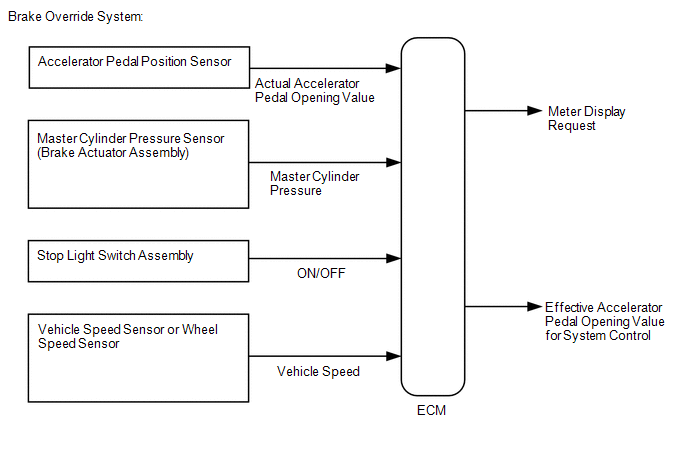DESCRIPTION When the vehicle is being driven, depressing the accelerator pedal sensor assembly and brake pedal will activate the brake override system to restrict driving torque. The conditions for activating the brake override system as well as the items that are controlled are explained below.  Activation Conditions: Activation Conditions:
NOTICE: The vehicle may not enter the brake override system control due to the relation of the accelerator pedal angle and the vehicle's speed. Items Controlled:
HINT:
CAUTION / NOTICE / HINT Inspection MethodExample: Drive at 10 km/h (6.25 mph), depress the accelerator pedal by 1/2 to 3/4 and keep it in that position. Under these conditions, if the engine speed decreases to 1000 rpm when the brake pedal is depressed, then the brake override system has been activated. CAUTION: When carrying out the inspection, use a place where you are able to carry it out safely and also pay close attention to your surroundings. Also, when driving, make absolutely sure that all traffic laws, such as speed limits, are observed. HINT:
NOTICE: The brake override system restricts driving torque if the brake pedal is depressed when driving with the accelerator pedal depressed. If a customer reports experiencing loss of torque after the accelerator and brake pedals have both been intentionally depressed, explain to the customer that this is not a malfunction, and that the customer should avoid depressing both the accelerator and brake pedals at the same time. Example: While operating the accelerator pedal, the customer uses their left foot to operate the brake pedal. PROCEDURE
(a) Connect the Techstream to the DLC3. (b) Turn the ignition switch to ON and turn the Techstream on. (c) Enter the following menus: System Select / Health Check. (d) Check DTCs. Result
(a) Connect the Techstream to the DLC3. (b) Turn the ignition switch to ON and turn the Techstream on. (c) Start the engine. (d) Enter the following menus: Chassis / ABS/VSC/TRAC / Data List / Master Cylinder Sensor. (e) Read the value displayed on the Techstream.
(f) Check that the brake fluid pressure value of the "Master Cylinder Sensor" observed on the Techstream changes when the brake pedal is depressed. OK: When the pedal is depressed, the voltage displayed on the Techstream increases.
(a) Connect the Techstream to the DLC3. (b) Turn the ignition switch to ON and turn the Techstream on. (c) Enter the following menus: Powertrain / Engine and ECT / Data List / Stop Light Switch and ST1. (d) Check the Data List indication when the brake pedal is depressed and released. OK:
(a) Inspect and adjust the brake pedal (See page
HINT: If the stop light switch turns ON too late, the start of brake override system control may be delayed; if it turns ON too soon, brake override system control may begin too early, so conduct inspection of the brake pedal and stop light switch assembly.
(a) Connect the Techstream to the DLC3. (b) Turn the ignition switch to ON and turn the Techstream on. (c) Enter the following menus: Powertrain / Engine and ECT / Data List / Accel Sens. No. 1 Volt % and Accel Sens. No. 2 Volt %. (d) Read the value displayed on the Techstream. OK:
HINT: For numerical values of Accel Sens. No. 1 Volt % and Accel Sens. No. 2 Volt %, refer to the Data List (See page
(a) Connect the Techstream to the DLC3. (b) Turn the ignition switch to ON and turn the Techstream on. (c) Start the engine. (d) Enter the following menus: Powertrain / Engine and ECT / Data List / Vehicle Speed. (e) Read the value displayed on the Techstream. Standard:
CAUTION: When performing the confirmation driving pattern, obey all speed limits and traffic laws. HINT: Data can be captured relatively easily by using the snapshot function in the Data List. Confirm the data after performing the drive test.
(a) Connect the Techstream to the DLC3. (b) Turn the ignition switch to ON and turn the Techstream on. (c) Start the engine. (d) Enter the following menus: Chassis / ABS/VSC/TRAC / Data List / FR Wheel Speed, FL Wheel Speed, RR Wheel Speed and RL Wheel Speed. (e) Read the value displayed on the Techstream. Standard:
CAUTION: When performing the confirmation driving pattern, obey all speed limits and traffic laws. HINT: Data can be captured relatively easily by using the snapshot function in the Data List. Confirm the data after performing the drive test.
|
Toyota Tundra Service Manual > Front Seat Assembly(for Manual Seat): Installation
INSTALLATION CAUTION / NOTICE / HINT HINT: Use the same procedure for the RH and LH sides. The procedure listed below is for the LH side. PROCEDURE 1. INSTALL FRONT SEAT ASSEMBLY LH (a) Place the front seat assembly LH in the cabin. NOTICE: Be careful not to damage the vehicle body. (b) Connect the ...